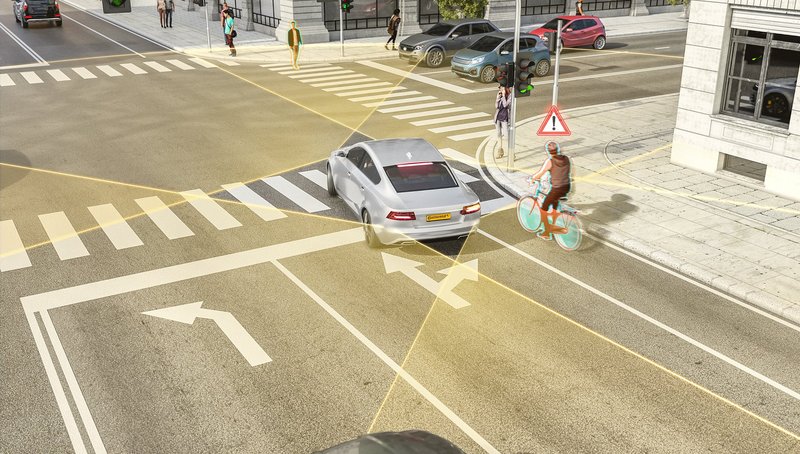Continental’s Next Generation Radar Technology Enables New Safety Features
- New short-range radar allows for more precise detection of vehicle surroundings
- Compact radar system operates within high-resolution 77 gigahertz range
- Right-Turn Assist System for passenger cars protects cyclists and pedestrians
AUBURN HILLS, Mich., August 19, 2019 — The technology company Continental has unveiled a new short-range radar that offers more precise detection of the vehicle’s surroundings, including movement and speed. This next-generation radar operates using 77 gigahertz (GHz) technology, detecting the environment at a higher resolution and with greater accuracy than the previous 24 GHz version. Additionally, the individual components of the system, such as the antenna and the radio-frequency chip, are now housed in a smaller installation space, making vehicle install easier even in confined places.
“Radar sensors are a fundamental tool for advanced driver assistance systems and with every new generation, we enable more advanced features for the vehicle of the future,” said Amit Kapoor, head of the Advanced Driver Assistance Systems business unit for Continental, North America. “When it comes to the progression of assisted and automated driving technology, Continental is focused on both the building-block technologies and on the driving functions as a whole.”
This new short-range radar is just one environmental sensor within Continental’s product portfolio of future-oriented advanced driver assistance systems (ADAS). Continental offers ADAS safety products and functions, as well as system solutions for assisted and automated driving including long-range radar, camera, surround view systems, high resolution 3D flash LIDAR and electronic control units.
Enhanced detection of vehicle surroundings enables new safety functions
Continental’s next-generation radar sensors can be positioned at each of the vehicle body’s four corners to ensure virtually seamless 360-degree monitoring of the vehicle surroundings. Full monitoring systems form the basis for many ADAS functions, such as monitoring vehicle blind spots, cross-traffic detection for Emergency Brake Assist systems, as well as monitoring the area behind the vehicle to ensure that vehicle occupants can get out safely if a vehicle or a cyclist is approaching from behind.
Demonstrating the possibilities created by these higher resolution sensors, Continental has developed a Right-Turn Assist System for passenger cars. In urban areas, a driver turning right may not be aware that a cyclist is about to pass along the side of the vehicle. The short-range radar can detect a cyclist approaching from behind, triggering the Right-Turn Assist function if the driver proceeds to turn. In such a situation, the sensors transmit a signal to the brakes and the car stops before the car and cyclist collide. This safety function can also protect pedestrians walking or on a scooter.
From 2000 to 2017, bicycle commuting has grown by more than 40 percent nationwide in the United States, according to the U.S. Census Bureau. Biking to work has many positive benefits, including improved personal health and a lower carbon footprint, but where the infrastructure has not been designed for safe bicycle and vehicle interaction can be dangerous. According to the National Highway Traffic Safety Association, cyclist fatalities disproportionately take place in urban areas. Right Turn Assist has the potential to help eliminate some of these dangers by increasing drivers’ awareness of the environment around them.
Emergency Steer Assist system also made possible with new radar technology
Right-Turn Assist is not the only new function made possible by Continental’s new 77 GHz short-range radar technology. Emergency Steer Assist can also be implemented based on data from the new radar. In the event of a sudden avoidance maneuver, this system allows the vehicle to be steered away from the collision-risk area. Using the radar system, Emergency Steer Assist can recognize other road users nearby, including their trajectories and speeds, and can adjust the steering signals accordingly. Continental’s new radar technology is just one of the latest developments in the company’s longstanding commitment toward its goal of Vision Zero – zero traffic fatalities, injures and crashes.
Continental develops pioneering technologies and services for sustainable and connected mobility of people and their goods. Founded in 1871, the technology company offers safe, efficient, intelligent, and affordable solutions for vehicles, machines, traffic and transportation. In 2018, Continental generated sales of €44.4 billion and currently employs more than 244,000 people in 60 countries and markets.

Kathryn Blackwell
Vice President, Marketing & Communications


